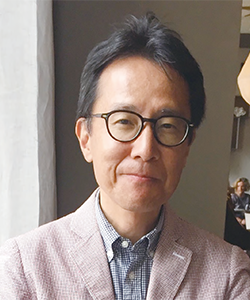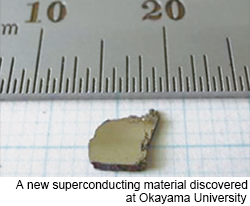Home > Research > Pickup > minoru_nohara
Realizing a Low-Carbon Society with New Materials:Development of new superconducting and thermoelectric materials

Minoru Nohara
Professor of Physics
After graduating from Hiroshima University Department of Physics, Faculty of Science, he received his Ph.D. in physics from Hiroshima University Graduate School of Science. After serving as a Research Associate at the Institute for Solid State Physics, University of Tokyo, he became an Associate Professor at The University of Tokyo Graduate School of Frontier Sciences. From August 2008 until today, he has served as a full Professor at the Research Institute for Interdisciplinary Science (RIIS), Okayama University.
Professor Nohara's research lab has been discovering new superconducting and thermoelectric materials. These could become key materials for the end of global warming: with superconductivity, power can be transmitted with zero loss, and with thermoelectricity, electricity is generated from waste heat.
"My favorite thing to do is to look at and think about the periodic table of elements. In the possible limitless combinations which combinations would enable the realization of high-temperature superconductivity? Certain ideas come to me when I think this way."
Professor Nohara is a leader in the development of new materials for superconductivity and other applications. The entire world has paid attention to his discoveries, including iron-based superconductors. He has been recently engaged in the development of novel thermoelectric materials that can generate electricity from waste heat.
New superconducting material from Okayama!

The first experiments conducted by Dr. Nohara at Okayama University regarded the combination of three elements?calcium, iron, and arsenic?with other single elements. A fourth-year undergraduate student discovered that by using platinum, the material showed signs of superconductivity at a relatively high temperature of minus 235 degrees Centigrade (absolute temperature: 38 Kelvins).
"We were really so excited. I had never dreamed that we would be able to discover a material that had superconductivity at such a high temperature."
"To present a new material having superconductivity to an academic conference, there must be proof through experiments of many things: its chemical components, determination of its crystal structure, and zero electrical resistance. There are really a multitude of things that must be done first."
For a full year Professor Nohara's group worked, producing more than 120 sample materials under different synthesis conditions and with differing element ratios, and successfully identified the properties of this superconductor. To do so, the team mobilized the most advanced testing apparatuses, including an electron probe microanalyzer from Okayama University's Department of Earth Sciences. A synchrotron-radiation structural analysis was performed at a synchrotron radiation facility (SPring-8). The material had a unique crystal structure which had never been seen before, with alternate stacking of the iron and platinum layers. The discovery of a compound with mixed transition metal elements and superconductivity at the highest temperature ever in the world had a major impact on the field of superconductivity research.
Using waste heat to generate electricity
The next target of the Nohara Lab was the development of new rare metal-free thermoelectric materials. Electrons in a conductor carry both heat flow and an electric current. The heat flow also generates a simultaneous flow of electricity. Thermoelectric materials are materials that demonstrate this property in a remarkable way. It is said that approximately 70% of the energy used by modern society escapes to the environment as waste heat. Waste heat is generated at fossil-fuel burning electricity plants, by cars, at trash incineration plants, and even in the heat used to make a hot bath in the bathtub. Thermoelectric power generation will make it possible to directly derive electrical energy from this waste heat. Professor Nohara estimates that the annual CO2 emissions in Japan can be reduced by approximately 3% with thermoelectric power generation.
"For the widespread dissemination in society of thermoelectric power, it will be necessary to realize power generation efficiency with low-priced materials. Recently a theory was proposed to use the flat-band mechanism as a means of dramatically increasing generation efficiency. We are currently searching for novel combinations of elements so as to realize this theory; all while using rare metal-free materials."
In the pursuit of this research, Professor Nohara has the strong backing of a national project; the Advanced Low Carbon Technology Research and Development Program (ALCA). Already there has been successful development of a new material that has an electrical generation performance 1.5 times that of conventional materials.
Making dreams come true
When Professor Nohara was in his first year at university, the Swiss physicists Bednorz and Müller discovered high-temperature superconductivity in copper oxide, for which they received the Nobel Prize in Physics the very next year (1987). One could say that this news determined the future life of Dr. Nohara.
"In high school, I had never heard of superconductivity. Learning of the discovery of Bednorz and Müller, I moved into the superconductivity lab for my graduation research. Even today I dream of higher temperature superconductivity; if possible, room-temperature superconductivity. So, everyone, what is your dream? What would you like to accomplish in the future? Please take time to think carefully about this. Our mission as university professors is to help you to realize your dreams."







